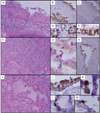Pulmonary pathologic findings of fatal 2009 pandemic influenza A/H1N1 viral infections
- PMID: 20121613
- PMCID: PMC2819217
- DOI: 10.5858/134.2.235
Pulmonary pathologic findings of fatal 2009 pandemic influenza A/H1N1 viral infections
Abstract
Context: In March 2009, a novel swine-origin influenza A/H1N1 virus was identified. After global spread, the World Health Organization in June declared the first influenza pandemic in 41 years.
Objective: To describe the clinicopathologic characteristics of 34 people who died following confirmed A/H1N1 infection with emphasis on the pulmonary pathology findings.
Design: We reviewed medical records, autopsy reports, microbiologic studies, and microscopic slides of 34 people who died between May 15 and July 9, 2009, and were investigated either by the New York City Office of Chief Medical Examiner (32 deaths) or through the consultation service of a coauthor (2 deaths).
Results: Most of the 34 decedents (62%) were between 25 and 49 years old (median, 41.5 years). Tracheitis, bronchiolitis, and diffuse alveolar damage were noted in most cases. Influenza viral antigen was observed most commonly in the epithelium of the tracheobronchial tree but also in alveolar epithelial cells and macrophages. Most cases were reverse transcription-polymerase chain reaction positive for influenza. Histologic and microbiologic autopsy evidence of bacterial pneumonia was detected in 55% of cases. Underlying medical conditions including cardiorespiratory diseases and immunosuppression were present in 91% of cases. Obesity (body mass index, >30) was noted in 72% of adult and adolescent cases.
Conclusions: The pulmonary pathologic findings in fatal disease caused by the novel pandemic influenza virus are similar to findings identified in past pandemics. Superimposed bacterial infections of the respiratory tract were common. Preexisting obesity, cardiorespiratory diseases, and other comorbidities also were prominent findings among the decedents.
Figures


Similar articles
-
Predictive clinicopathological features derived from systematic autopsy examination of patients who died with A/H1N1 influenza infection in the UK 2009-10 pandemic.Health Technol Assess. 2010 Dec;14(55):83-114. doi: 10.3310/hta14550-02. Health Technol Assess. 2010. PMID: 21208548
-
Postmortem findings in eight cases of influenza A/H1N1.Mod Pathol. 2010 Nov;23(11):1449-57. doi: 10.1038/modpathol.2010.148. Epub 2010 Aug 27. Mod Pathol. 2010. PMID: 20802471
-
Histopathological and immunohistochemical findings of 20 autopsy cases with 2009 H1N1 virus infection.Mod Pathol. 2012 Jan;25(1):1-13. doi: 10.1038/modpathol.2011.125. Epub 2011 Aug 26. Mod Pathol. 2012. PMID: 21874012
-
Pandemic novel 2009 H1N1 influenza: what have we learned?Semin Respir Crit Care Med. 2011 Aug;32(4):393-9. doi: 10.1055/s-0031-1283279. Epub 2011 Aug 19. Semin Respir Crit Care Med. 2011. PMID: 21858744 Review.
-
Hemophagocytic lymphohistiocytosis associated with influenza A (H1N1) infection in a patient with chronic lymphocytic leukemia: an autopsy case report and review of the literature.Ann Diagn Pathol. 2012 Dec;16(6):477-84. doi: 10.1016/j.anndiagpath.2011.03.009. Epub 2011 Jul 2. Ann Diagn Pathol. 2012. PMID: 21724431 Review.
Cited by
-
Insights into pathogenesis of fatal COVID-19 pneumonia from histopathology with immunohistochemical and viral RNA studies.Histopathology. 2020 Dec;77(6):915-925. doi: 10.1111/his.14201. Epub 2020 Oct 16. Histopathology. 2020. PMID: 32614086 Free PMC article.
-
Phenotypic differences in virulence and immune response in closely related clinical isolates of influenza A 2009 H1N1 pandemic viruses in mice.PLoS One. 2013;8(2):e56602. doi: 10.1371/journal.pone.0056602. Epub 2013 Feb 18. PLoS One. 2013. PMID: 23441208 Free PMC article.
-
Impaired wound healing predisposes obese mice to severe influenza virus infection.J Infect Dis. 2012 Jan 15;205(2):252-61. doi: 10.1093/infdis/jir729. Epub 2011 Dec 5. J Infect Dis. 2012. PMID: 22147799 Free PMC article.
-
Viruses associated with pneumonia in adults.Clin Infect Dis. 2012 Jul;55(1):107-13. doi: 10.1093/cid/cis297. Epub 2012 Mar 15. Clin Infect Dis. 2012. PMID: 22423119 Free PMC article. Review.
-
MEK-inhibitor treatment reduces the induction of regulatory T cells in mice after influenza A virus infection.Front Immunol. 2024 Jun 24;15:1360698. doi: 10.3389/fimmu.2024.1360698. eCollection 2024. Front Immunol. 2024. PMID: 38979428 Free PMC article.
References
-
- Thompson WW, Shay DK, Weintraub E, et al. Mortality associated with influenza and respiratory syncytial virus in the United States. JAMA. 2003;289(2):179–186. - PubMed
-
- Johnson NP, Mueller J. Updating the accounts: global mortality of the 1918–1920 “Spanish” influenza pandemic. Bull Hist Med. 2002;76(1):105–115. - PubMed
MeSH terms
Grants and funding
LinkOut - more resources
Full Text Sources
Other Literature Sources
Medical
Miscellaneous

